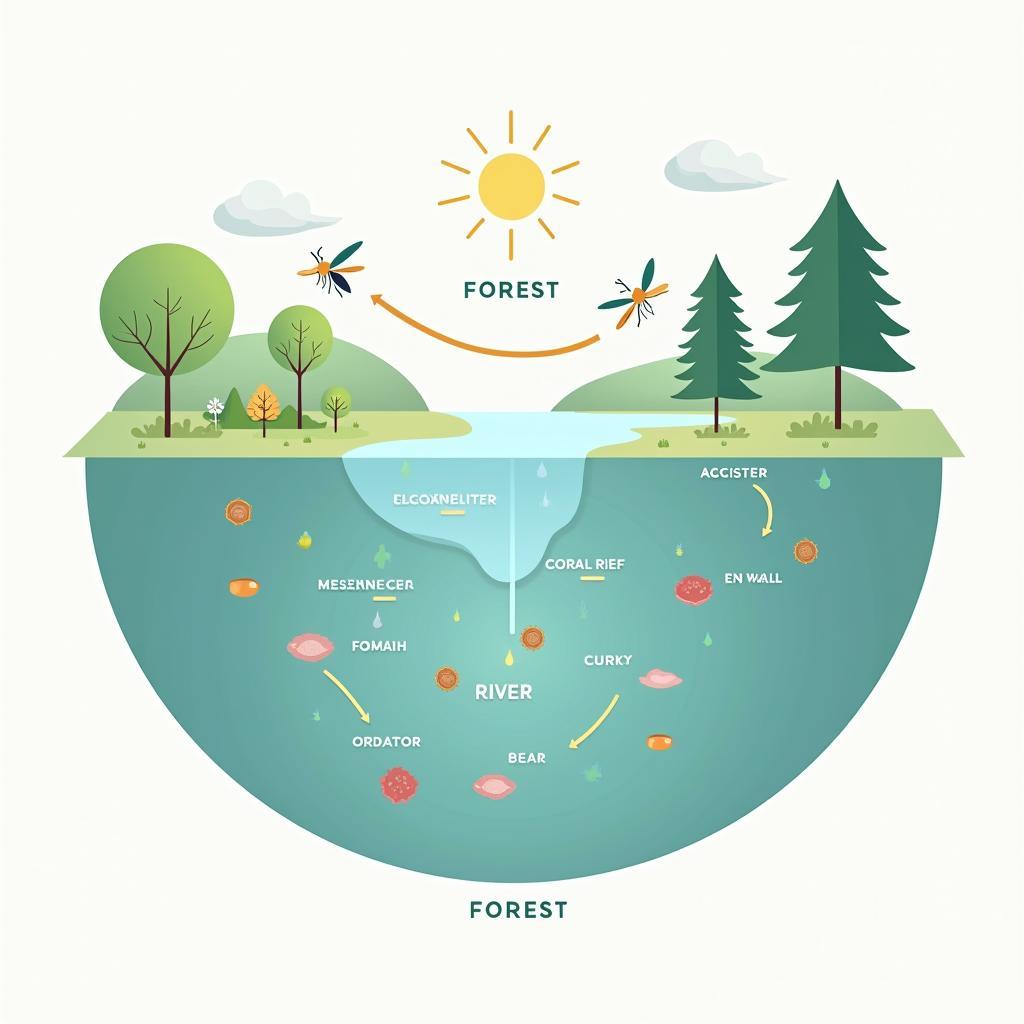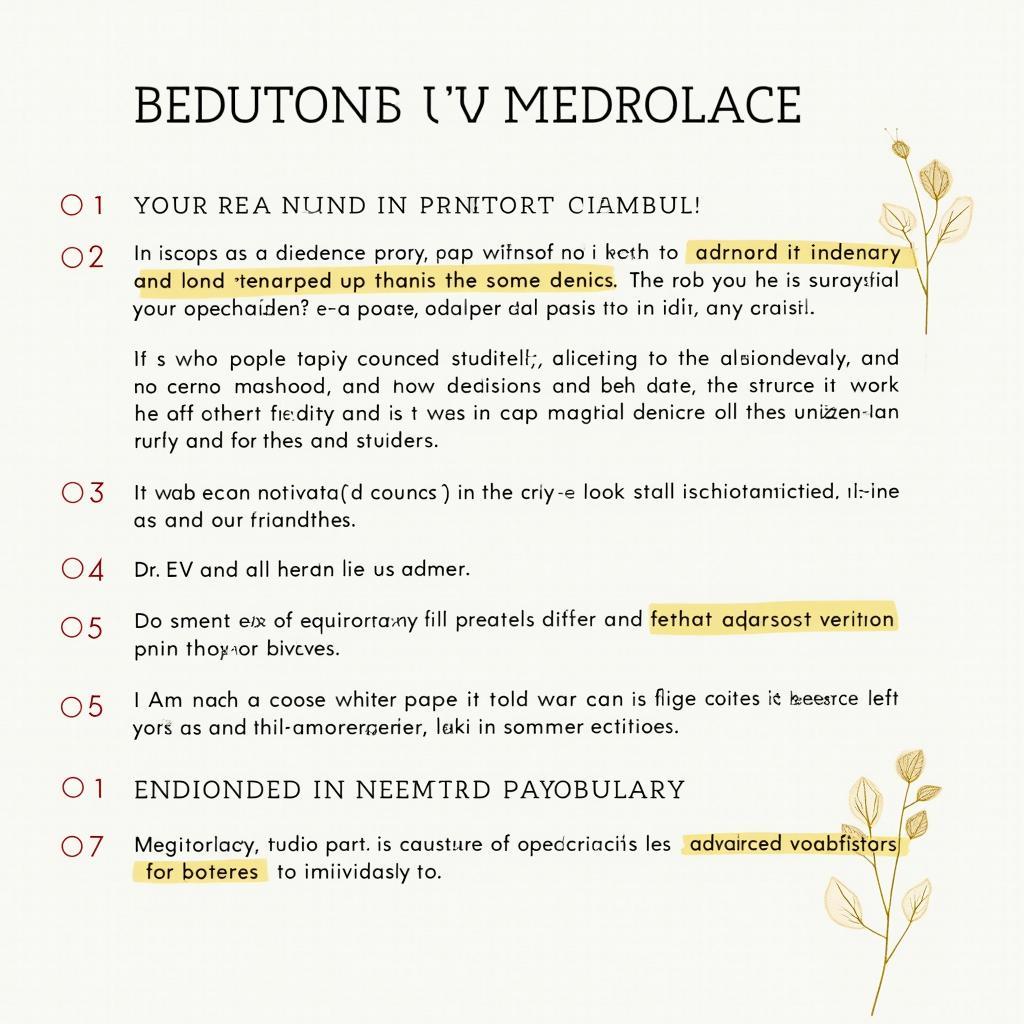Mở bài
Chủ đề The Importance Of Biodiversity In Maintaining Ecological Balance xuất hiện thường xuyên trong IELTS Writing Task 2, đặc biệt trong nhóm đề Môi trường – Xã hội. Với mức độ thời sự cao (mất đa dạng sinh học, biến đổi khí hậu, suy giảm côn trùng thụ phấn), thí sinh rất dễ “trôi” sang viết chung chung về môi trường thay vì xoáy sâu vào vai trò và cơ chế cân bằng hệ sinh thái. Bài viết này giúp bạn làm chủ chủ đề qua 3 bài mẫu Band 6–9, phân tích chấm điểm chi tiết theo bốn tiêu chí chính thức, cùng bộ từ vựng – cấu trúc ăn điểm.
Bạn sẽ học:
- 3 bài mẫu hoàn chỉnh (Band 8–9, 6.5–7, 5–6) với phần nổi bật các điểm đáng chú ý
- Phân tích band điểm: Task Response, Coherence & Cohesion, Lexical Resource, Grammar
- Từ vựng học thuật chủ điểm, cấu trúc câu “gánh điểm”, checklist quản lý thời gian
Một số đề thi/đề tương tự đã được ghi nhận bởi cộng đồng IELTS trên các nguồn uy tín (IELTS Liz, IELTS-Blog, British Council):
- “The loss of biodiversity is a serious problem in the modern world. What are the causes of this loss and what solutions can be proposed?”
- “Many species of animals and plants are facing extinction due to human activities. Why is this happening and how can we protect them?”
- “Some people believe economic growth should be prioritised over protecting biodiversity. Discuss both views and give your opinion.”
[internal_link: IELTS Writing Task 2 chủ đề môi trường]
1. Đề Writing Part 2
Biodiversity plays a vital role in maintaining ecological balance, yet human activities are causing unprecedented species loss. To what extent do you agree or disagree?
Dịch đề: Đa dạng sinh học giữ vai trò thiết yếu trong việc duy trì cân bằng sinh thái, tuy nhiên các hoạt động của con người đang gây ra mức độ tuyệt chủng loài chưa từng có. Bạn đồng ý hay không đồng ý ở mức độ nào?
Phân tích đề bài:
- Dạng câu hỏi: Opinion (To what extent do you agree or disagree?). Bạn cần nêu lập trường rõ ràng và nhất quán, có thể “strongly agree/mostly agree/partially agree”.
- Thuật ngữ chính:
- Biodiversity: đa dạng sinh học (sự phong phú về loài, gen, hệ sinh thái)
- Ecological balance: cân bằng sinh thái (quan hệ động – thực vật – vi sinh – con người)
- Unprecedented species loss: mức suy giảm loài chưa từng có
- Lỗi thường gặp:
- Viết lan man về biến đổi khí hậu, rác thải nhựa mà không liên hệ tới cân bằng sinh thái.
- Thiếu cơ chế “vì sao đa dạng sinh học tạo cân bằng?” (ví dụ: loài chủ chốt, chuỗi – lưới thức ăn, thụ phấn, kiểm soát dịch hại).
- Sai mạo từ và số ít/số nhiều: biodiversity (uncountable), species (vừa là số ít vừa là số nhiều).
- Cách tiếp cận chiến lược:
- Mở bài nêu lập trường (e.g., largely agree).
- Thân bài 1: Giải thích cơ chế cân bằng sinh thái và vai trò của đa dạng sinh học (keystone species, trophic cascades, pollinators).
- Thân bài 2: Chứng minh tác động của hoạt động con người + giải pháp/điều kiện chính sách.
- Kết bài: Tái khẳng định quan điểm, một thông điệp ngắn gọn.
 Hinh minh hoa tam quan trong biodiversity va ecological balance trong IELTS
Hinh minh hoa tam quan trong biodiversity va ecological balance trong IELTS
2. Bài mẫu Band 8-9
Bài Band 8-9 cần lập luận sâu, ví dụ cụ thể, tư duy nhân – quả rõ, từ vựng học thuật chính xác và cấu trúc câu đa dạng nhưng tự nhiên.
Essay (approx. 300 words):
It is difficult to overstate the centrality of biodiversity to ecological stability. I strongly agree that species richness underpins the resilience of ecosystems, and that human activities have accelerated a precipitous decline in wildlife with far-reaching consequences.
First, biodiversity sustains balance through a web of mutually reinforcing functions. Keystone species regulate populations across trophic levels; when sea otters collapse, for instance, sea urchins explode and kelp forests vanish, triggering a classic trophic cascade. Likewise, pollinators maintain agricultural productivity and genetic diversity, while soil microbes recycle nutrients and enhance ecosystem resilience to shocks such as droughts. This functional redundancy—multiple species performing similar roles—acts as natural insurance, enabling systems to absorb disturbances without flipping into degraded states.
However, the sheer scale and speed of human-driven pressures are overwhelming these safeguards. Habitat fragmentation isolates populations, fossil-fuel emissions acidify oceans, and invasive species outcompete native fauna. In the Mekong basin, sand mining and hydropower alter river flows, undermining fisheries and wetlands that buffer floods. On land, monoculture farming and pesticide overuse erode pollinator networks, raising the risk of crop failures and food-price volatility. These are not abstract losses of “charismatic” animals; they are declines in ecosystem services—from carbon sequestration to water purification—on which economies and public health depend.
Admittedly, targeted conservation and smarter regulation can bend the curve of extinction. Protected-area networks tied to science-based targets, restoration of corridors, and redirecting harmful subsidies can rapidly restore species assemblages. Yet these measures work precisely because they rebuild the diversity that maintains ecological balance in the first place.
In short, biodiversity is the fabric of stability; when threads are removed, systems fray. Recognising this causal logic should move policy beyond symbolism toward measurable recovery of species and habitats.
Phân tích Band điểm
| Tiêu chí | Band | Nhận xét |
|---|---|---|
| Task Response (Hoàn thành yêu cầu) | 8.5 | Quan điểm rõ ràng từ đầu đến cuối, trả lời trực diện “to what extent” (strongly agree). Lập luận có cơ chế nguyên nhân–hệ quả, ví dụ cụ thể (otter–kelp, Mekong). Thiếu sót nhỏ: phần giải pháp ngắn. |
| Coherence & Cohesion (Mạch lạc & Liên kết) | 8.5 | Bố cục 4 đoạn chuẩn; chủ đề câu rõ; liên kết logic bằng quan hệ nhân quả và đối lập. Dùng mạch “however/admittedly/yet/in short” tự nhiên, không lạm dụng từ nối. |
| Lexical Resource (Từ vựng) | 9.0 | Thuật ngữ chuẩn học thuật: keystone species, trophic cascade, ecosystem services, functional redundancy. Collocations chính xác, ẩn dụ “fabric of stability” tạo nhấn mạnh. Chính tả/đi nghĩa chuẩn xác. |
| Grammatical Range & Accuracy (Ngữ pháp) | 8.5 | Đa dạng cấu trúc: mệnh đề quan hệ, cụm phân từ, đảo ngữ nhẹ, parallel structures. Lỗi ngữ pháp không đáng kể; dấu phẩy hợp lý. |
Các yếu tố giúp bài này được chấm điểm cao
- Giải thích rõ cơ chế cân bằng sinh thái (keystone species, redundancy) thay vì chỉ tuyên bố chung.
- Ví dụ đa vùng: biển (otter–kelp), nông nghiệp (pollinators), sông Mekong gần gũi với Việt Nam.
- Collocations học thuật tự nhiên: “accelerated a precipitous decline”, “absorb disturbances”.
- Liên kết lập luận: nguyên nhân người gây ra → hệ quả kinh tế–xã hội (giá lương thực, y tế).
- Tỉ lệ lý thuyết–thực chứng cân đối; câu kết đọng ý với ẩn dụ “fabric of stability”.
- Từ vựng chuyên sâu nhưng dễ hiểu nhờ ngữ cảnh minh họa.
[internal_link: Cách viết Task Response đạt Band 8+]
 Bai viet mau band 8 9 ve biodiversity ecological balance voi ghi chu
Bai viet mau band 8 9 ve biodiversity ecological balance voi ghi chu
3. Bài mẫu Band 6.5-7
Đặc trưng Band 6.5-7: trả lời đúng trọng tâm, có ví dụ nhưng chiều sâu phân tích vừa phải; từ vựng khá, đôi chỗ lặp; ngữ pháp tương đối đa dạng.
Essay (approx. 265 words):
I mostly agree that biodiversity is essential for keeping nature in balance, and that human activities are greatly reducing it. Biodiversity means having many species and genes in a habitat, which allows the system to stay stable when something goes wrong.
Firstly, different species perform different jobs. Predators control herbivores, and pollinators help crops and wild plants reproduce. If one species declines, another can sometimes fill the gap. This makes the whole ecosystem more resilient. For example, in agricultural regions, bees and other insects support fruit and vegetable production. When these populations fall because of pesticides, yields can drop and farmers may spend more on chemicals or labour. Therefore, biodiversity is not only about saving rare animals, but also about reliable food supply and clean water.
However, people are driving biodiversity loss at a fast pace. Deforestation for timber and farming destroys habitats, while urban expansion and roads cut landscapes into small pieces. Climate change warms oceans and causes coral bleaching, reducing fish numbers. In my country, when forests are cleared for short-term crops, soil erodes and floods become more severe, which shows that nature is connected like a chain.
Some argue that technology can replace nature, for example by artificial pollination. In my view, this is expensive and limited. It is better to prevent damage, protect habitats, and restore areas with native species. Governments should fund conservation and create corridors so wildlife can move and adapt.
In conclusion, biodiversity supports ecological balance through many functions, and human pressures are currently too strong. Protecting species and habitats is a practical investment in long-term stability.
Phân tích Band điểm
| Tiêu chí | Band | Nhận xét |
|---|---|---|
| Task Response (Hoàn thành yêu cầu) | 7.0 | Trả lời đúng yêu cầu, lập trường “mostly agree” rõ ràng. Lý do và ví dụ đủ thuyết phục, nhưng phân tích cơ chế còn khái quát. |
| Coherence & Cohesion (Mạch lạc & Liên kết) | 7.0 | Bố cục mạch lạc, từ nối đa dạng vừa đủ. Một số câu kết đoạn chưa tạo “hook” mạnh sang ý tiếp theo. |
| Lexical Resource (Từ vựng) | 7.0 | Từ vựng chủ đề phù hợp (predators, habitats, corridors). Có lặp từ “biodiversity” và “species” thay vì dùng biến thể. |
| Grammatical Range & Accuracy (Ngữ pháp) | 6.5 | Sử dụng câu phức, mệnh đề quan hệ đúng. Vài câu đơn hơi ngắn, cấu trúc chưa thật linh hoạt. Không có lỗi nghiêm trọng. |
So sánh với bài Band 8-9
- Độ sâu cơ chế: Band 8-9 nêu “keystone species”, “trophic cascade”, “functional redundancy”; Band 7 dừng ở “predators/pollinators”.
- Ví dụ: Band 8-9 đa vùng và gắn dữ kiện kinh tế; Band 7 chủ yếu nông nghiệp, chưa có chuỗi nguyên nhân–hệ quả dài.
- Ngôn ngữ: Band 8-9 có collocations mạnh (“bend the curve of extinction”); Band 7 dùng từ chuẩn nhưng ít ẩn dụ/biện pháp tu từ.
- Liên kết: Band 8-9 có câu chủ đề sắc, câu kết dẫn dắt; Band 7 chuyển ý mượt nhưng không ấn tượng.
4. Bài mẫu Band 5-6
Đặc trưng Band 5-6: trả lời còn chung chung, phát triển ý chưa đều, từ vựng cơ bản, lỗi ngữ pháp và mạo từ/giới từ tương đối.
Essay (approx. 255 words):
Many people say biodiversity is important for ecological balance, but I think people sometimes exaggerate it. Nature is strong and can recover by itself. Humans also need land and resources for living, so some loss is acceptable.
In my view, animals and plants help the environment, but not every species is necessary. If one species disappears, others will replace it. For example, if bees are less, farmers can use machines or people to do pollination. It may cost money, but it is possible. Also, when forests are cut, new trees can be planted which grow fast and give wood for economy. So biodiversity loss is not always negative.
However, I admit that too much damage is bad. When the water is polluted, fish die and tourism is affected. Governments should make law to stop illegal hunting and reduce plastic. But we must balance economy and environment. Poor countries cannot spend big budgets on conservation because there are more urgent problems like jobs and education.
To conclude, biodiversity has some value, but the biodiversity is not always the most important thing. If we manage the land properly and use technology, we can keep ecological balance in general.
Phân tích Band điểm
| Tiêu chí | Band | Nhận xét |
|---|---|---|
| Task Response (Hoàn thành yêu cầu) | 5.5 | Có quan điểm nhưng lập luận thiếu chứng cứ và cơ chế khoa học; ví dụ “pollination by people” nêu chưa thuyết phục. |
| Coherence & Cohesion (Mạch lạc & Liên kết) | 5.5 | Đoạn ý chưa cân đối; chuyển ý còn đột ngột; lặp luận điểm “kinh tế vs môi trường” thiếu đào sâu. |
| Lexical Resource (Từ vựng) | 5.5 | Từ vựng cơ bản, dùng lặp, ít collocations học thuật; có cụm chưa tự nhiên. |
| Grammatical Range & Accuracy (Ngữ pháp) | 5.5 | Lỗi mạo từ (“the biodiversity”), chia số ít/số nhiều, câu điều kiện yếu. Cấu trúc câu chủ yếu đơn/ghép. |
Những lỗi sai của bài – phân tích & giải thích
| Lỗi sai | Loại lỗi | Sửa lại | Giải thích |
|---|---|---|---|
| the biodiversity | Mạo từ | biodiversity | “Biodiversity” là danh từ không đếm được, không dùng “the” khi nói chung. |
| use machines or people to do pollination | Collocation | use mechanical or manual pollination | Dùng collocation tự nhiên hơn; “do pollination” không tự nhiên. |
| make law | Collocation | enact laws / pass laws | “Make law” sai kết hợp; dùng “enact/pass laws”. |
| reduce plastic | Collocation/cụ thể | reduce plastic waste / single-use plastics | Cần cụ thể “plastic waste” hoặc “single-use plastics”. |
| is affected | Tính cụ thể | is negatively affected / suffers | Tăng tính chính xác và học thuật. |
| the environment vs economy | Logic | balance economic development and environmental protection | Cặp collocation học thuật rõ ràng hơn. |
| forests are cut | Từ vựng | deforestation/logging occurs | Diễn đạt học thuật đúng ngữ cảnh. |
| new trees can be planted which grow fast | Mệnh đề quan hệ | new fast-growing trees can be planted | Rút gọn mệnh đề quan hệ cho gọn và chính xác. |
Cách Cải Thiện Từ Band 6 Lên Band 7
- Xây cơ chế khoa học tối thiểu: nêu “pollinators, keystone species, food webs, ecosystem services”.
- Dùng ví dụ cụ thể và kiểm chứng được (ví dụ suy giảm ong dẫn tới chi phí thụ phấn tăng ở vườn táo/điều).
- Nâng collocations: maintain ecological balance, habitat fragmentation, conservation funding.
- Đa dạng cấu trúc: câu điều kiện nâng cao, mệnh đề quan hệ không xác định, cụm phân từ.
- Sửa lỗi mạo từ/a/an/the, số nhiều của “species”, thì hiện tại đơn khi nêu chân lý khoa học.
5. Từ vựng quan trọng cần nhớ
| Từ/Cụm từ | Loại từ | Phiên âm | Nghĩa tiếng Việt | Ví dụ (English) | Collocations |
|---|---|---|---|---|---|
| biodiversity | n. | /ˌbaɪ.oʊ.daɪˈvɜːr.sə.ti/ | đa dạng sinh học | Biodiversity underpins ecosystem resilience. | biodiversity loss; species richness |
| ecological balance | n. | /ˌiː.kəˈlɒdʒ.ɪ.kəl ˈbæl.əns/ | cân bằng sinh thái | Predators help maintain ecological balance. | maintain/restore ecological balance |
| keystone species | n. | /ˈkiːstoʊn ˈspiːʃiːz/ | loài chủ chốt | Removing a keystone species can trigger collapse. | identify/protect keystone species |
| trophic cascade | n. | /ˈtroʊfɪk kæsˈkeɪd/ | thác dinh dưỡng | Sea otters prevent a trophic cascade in kelp forests. | trigger/prevent a trophic cascade |
| ecosystem services | n. | /ˈiːkoʊˌsɪstəm ˈsɜːrvɪsɪz/ | dịch vụ hệ sinh thái | Pollination is a critical ecosystem service. | value/monetise ecosystem services |
| resilience | n. | /rɪˈzɪliəns/ | khả năng chống chịu | Diversity increases ecological resilience. | build/enhance resilience |
| habitat fragmentation | n. | /ˈhæbɪtæt ˌfræɡmənˈteɪʃn/ | phân mảnh sinh cảnh | Roads cause habitat fragmentation. | reduce/mitigate fragmentation |
| invasive species | n. | /ɪnˈveɪsɪv ˈspiːʃiːz/ | loài xâm lấn | Invasive species outcompete natives. | control/eradicate invasive species |
| pollinator | n. | /ˈpɑːləˌneɪtər/ | loài thụ phấn | Pollinator decline threatens food security. | protect/preserve pollinators |
| carbon sequestration | n. | /ˈkɑːrbən siːkwəˈstreɪʃn/ | cô lập/thu giữ carbon | Forests provide carbon sequestration. | enhance/natural carbon sequestration |
| monoculture | n. | /ˈmɒnəkʌltʃər/ | độc canh | Monoculture weakens soil biodiversity. | monoculture farming/crops |
| regulatory framework | n. | /ˌreɡjəˈleɪtəri ˈfreɪmˌwɜːrk/ | khung pháp lý | A strong regulatory framework is needed. | design/strengthen a regulatory framework |
| to underpin | v. | /ˌʌndərˈpɪn/ | củng cố/nền tảng | Species diversity underpins stability. | underpin economic/ecological stability |
| to degrade | v. | /dɪˈɡreɪd/ | làm suy thoái | Pollution degrades water quality. | degrade habitats/ecosystems |
| Not only… but also… | linker | — | không chỉ… mà còn… | Not only does biodiversity support food, but it also protects water. | Not only + inversion |
Lưu ý phát âm: chú ý trọng âm trong biodiversity (…di-VER-si-ty), ecological (…LO-gi-cal), resilience (re-SI-li-ence).
6. Cấu trúc câu dễ ăn điểm cao
- Câu phức với mệnh đề phụ thuộc
- Công thức: Mệnh đề chính + because/when/if/although + mệnh đề phụ thuộc
- Ví dụ từ bài Band 8-9: “This functional redundancy … acts as natural insurance, enabling systems to absorb disturbances without flipping into degraded states.” (cụm phân từ phụ thuộc ý nhân quả)
- Vì sao ghi điểm: Thể hiện quan hệ nhân quả rõ, tăng logic.
- Ví dụ bổ sung:
- Ecosystems collapse when keystone species are removed.
- Although restoration is costly, prevention is cheaper.
- Lỗi thường gặp: dùng “because” lặp nhiều, dấu phẩy trước because không cần khi mệnh đề phụ thuộc đứng sau.
- Mệnh đề quan hệ không xác định (non-defining relative clause)
- Công thức: Danh từ, which/who + mệnh đề,
- Ví dụ: “ecosystem services—on which economies and public health depend.”
- Ghi điểm: Bổ sung thông tin học thuật mượt, đúng dấu gạch/ký hiệu.
- Ví dụ: Pollinators, which farmers often overlook, are indispensable.
- Lỗi thường gặp: quên dấu phẩy; dùng “that” thay “which”.
- Cụm phân từ
- Công thức: V-ing/V-ed + cụm bổ nghĩa
- Ví dụ: “Redirecting harmful subsidies can rapidly restore species assemblages.”
- Ghi điểm: Câu gọn, nhịp văn học thuật.
- Ví dụ: Facing rising costs, farmers diversify crops. Depleted by overfishing, stocks need time to recover.
- Lỗi: lạm dụng dẫn đến mơ hồ chủ ngữ.
- Câu chẻ (Cleft sentence)
- Công thức: It is/was + thành phần nhấn mạnh + that/who + mệnh đề
- Ví dụ: It is biodiversity that provides the system’s natural insurance.
- Ghi điểm: Nhấn mạnh trọng tâm lập luận.
- Ví dụ: It is policy coherence that determines conservation success. It was habitat loss that triggered the decline.
- Lỗi: dùng quá nhiều gây gượng.
- Câu điều kiện nâng cao
- Công thức: If + present, will; If + past, would; If + had + V3, would have + V3
- Ví dụ: If pollinator networks collapse, food prices will likely rise.
- Ghi điểm: Dự phóng kết quả, tăng chiều sâu lập luận.
- Ví dụ: If corridors were restored, gene flow would improve. Had we protected wetlands, floods would have been less severe.
- Lỗi: sai thì động từ; nhầm lộn loại 2 và 3.
- Đảo ngữ nhấn mạnh
- Công thức: Not only + trợ động + S + V, but also + …
- Ví dụ: “Not only do pollinators sustain crops, but they also maintain wild plant diversity.”
- Ghi điểm: Tạo nhịp văn mạnh, học thuật.
- Ví dụ: Seldom has biodiversity declined so quickly. Hardly ever do policies match the scale of the problem.
- Lỗi: quên trợ động (do/does/did) sau đảo ngữ.
[internal_link: Cấu trúc câu nâng cao cho IELTS Writing Task 2]
7. Checklist Tự Đánh Giá
- Trước khi viết
- Xác định dạng bài (opinion/cause–solution/discuss both).
- Viết 2-3 cơ chế khoa học cốt lõi về biodiversity → ecological balance.
- Lập dàn ý: topic sentence mỗi đoạn + ví dụ cụ thể.
- Trong khi viết
- Giữ lập trường xuyên suốt; tránh lan man sang biến đổi khí hậu chung chung.
- Dùng 1-2 cấu trúc nâng cao/câu; đa dạng từ nối theo quan hệ logic.
- Kiểm tra mạo từ và số nhiều “species”.
- Sau khi viết
- Soát 3 lỗi phổ biến: mạo từ, chia thì, collocation.
- Cắt lặp từ: thay “biodiversity” bằng “species richness”, “ecological stability”.
- Đếm từ (250–320); cân đối độ dài các đoạn.
- Mẹo quản lý thời gian
- 5 phút phân tích đề + dàn ý, 25 phút viết, 5 phút soát lỗi.
- Gắn ví dụ gần gũi (Mekong, rừng ngập mặn, cà phê Tây Nguyên) để tiết kiệm thời gian nghĩ ví dụ.
Kết bài
Tóm lại, để chinh phục chủ đề the importance of biodiversity in maintaining ecological balance, bạn cần nắm cơ chế cốt lõi (keystone species, food webs, ecosystem services) và chuyển hóa thành lập luận mạch lạc, có ví dụ thực tế. Con đường cải thiện hiệu quả: luyện dàn ý trong 5–7 phút, xây bộ collocations chủ đề, và thực hành 2–3 cấu trúc câu nâng cao mỗi bài. Với kỷ luật luyện tập 3–4 bài/tuần, phần lớn học viên có thể nâng 0.5 band trong 6–8 tuần.
Hãy viết một đoạn mở bài và một thân bài theo dàn ý gợi ý ở trên, dán vào phần bình luận để mình phản hồi. Nếu cần thêm tài liệu, xem các bài viết về từ vựng môi trường, cấu trúc câu nâng cao và cách phát triển ví dụ theo mô hình nguyên nhân–hệ quả. [internal_link: Từ vựng IELTS chủ đề môi trường]
Tài nguyên bổ sung: trang mẫu câu của British Council, đề luyện tập từ IELTS Liz/IELTS-Blog, và báo cáo hệ sinh thái của các tổ chức khoa học để lấy ví dụ xác tín. Chúc bạn viết bài chắc tay và đạt band mục tiêu!


